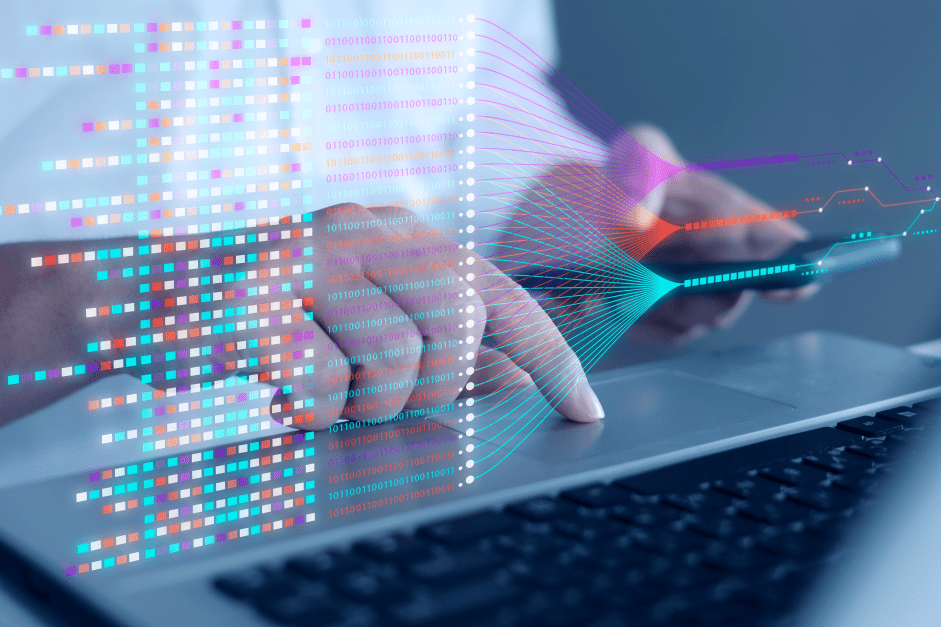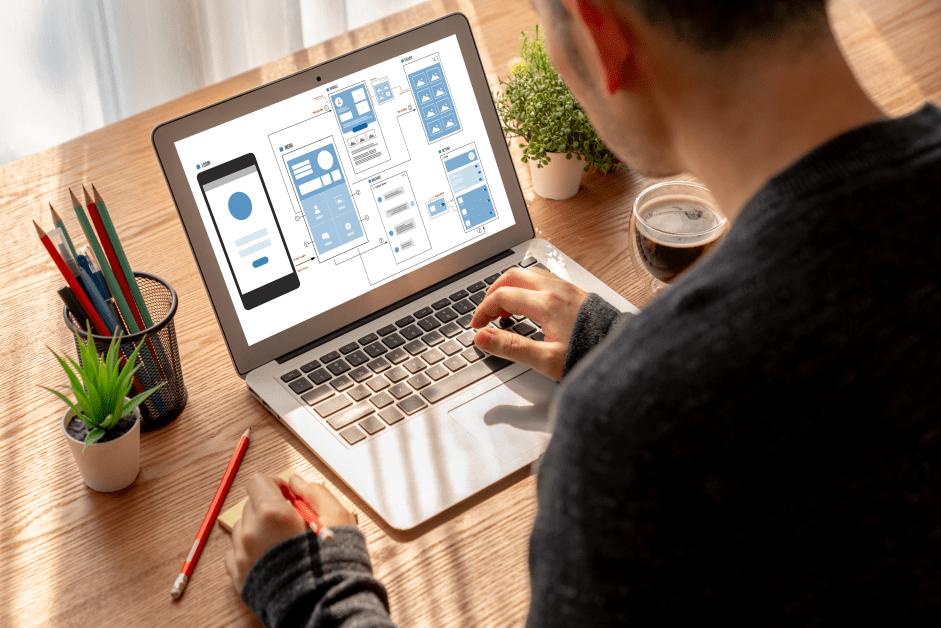How can we help?
Let’s talk about how we can help you transform your business.
Contact us
Application modernization is a process that usually involves updating older, legacy software applications to use more contemporary computing approaches, for example, either by migrating to use different programming languages, frameworks, libraries, runtimes, or just migrating to other platforms. That way, organizations can protect their investments and renew their software to be more secure, resilient, user-intuitive, and easier to manage. Also, by going through the application modernization process, organizations can step away from old, unreliable, and, in most cases, unsupported technologies.
Planning and implementing an app modernization strategy is significant in every company’s digital transformation strategy.
For example, imagine a company with a web API application developed in Java 8 that runs on on-premises servers. Companies can have numerous problems with this kind of setup, like Java 8’s end of life in 2030, the inability to scale up servers without high cost, the costs of servers running 24/7 regardless of application load, and the costs of server maintenance, backup, etc.
So, by implementing app modernization, a company can migrate existing applications to Java 17 or 21 and have all the latest technologies available, making them more reliable and secure. Also, companies can choose a cloud solution to host their application and get universally available, reliable, and scalable environments used only when needed. In most cases, this solution would be more cost-effective.
Application modernization trends are directions of change in the digital landscape, requiring companies to upgrade and modernize their IT systems to improve their business operations and stay competitive. However, organizations cannot blindly follow competitors, and each one must carefully evaluate how modernization benefits them now and in the long term. Some application modernization trends can be suitable and work for one organization, while others are not so critical. For other companies, the situation can be the opposite.
As mentioned before, following application modernization trends can play a significant role in the success and competitiveness of companies. Modernization of applications can help companies adopt more efficient development practices, improve the scalability of apps, and provide a better user experience. As a result of modernization, organizations can also experience improved application performance and lower infrastructure costs, and in general, it can help a company avoid technical debt. Some trends can also help with faster releases and, as such, quicker responses to the market’s demands. Legacy apps can benefit from improved security, lower maintenance costs and prolonged app life.
By accepting and implementing application modernization trends, the company remains adaptable, efficient, and competitive, promotes innovations, and is growth-oriented.
Incorporating Application Modernization Trends makes organizations innovative, agile, in-trend, and levelled with competitors. At this point, the top ten key application modernization trends that businesses follow and are implementing to increase competitiveness are:
This application modernization trend utilizes Artificial Intelligence and Machine Learning to improve decision-making, automate different processes, increase quality, and enhance user experiences. Companies use different AI tools to speed up the software development lifecycle, such as generating commonly used code, optimizing code, and automatically creating function unit tests and application tests. Such tools can help increase application quality and accelerate the app’s journey from code to customer.
Other usages include using AI and ML in virtual agents (chatbots) to help users, personalized recommendations, search suggestions, market analysis, market trends forecasting, improved ad targeting, data mining, etc.

DevOps’ approach to application modernization helps overcome the gap between development and operations teams by emphasizing team collaboration, automation, and continuous delivery. By accepting DevOps best practices, organizations can have more frequent and faster software deployments, which results in more reliable software releases. The DevOps approach enhances application quality by using automated testing and monitoring.
To achieve these goals, DevOps practices use methods like agile development, collaboration, Continuous Integration and Continuous Deployment (CICD), Infrastructure as Code (IAC), monitoring, feedback, and security Integration.
Cloud-native applications are designed and developed with a cloud environment in mind, usually using microservices architecture and containerization. Many modern cloud environments allow easy scaling up or down of applications either on demand or based on other parameters like the number of application requests, network load, CPU usage, memory usage, user-defined schedule, or rule.
One of the advantages of the cloud environment is its high availability. An application can be deployed onto multiple instances across different zones and regions. Unhealthy instances can be automatically and instantly replaced with healthy ones when they are needed.
Using applications hosted in a cloud environment is usually more cost-effective than on-premises servers. Cloud environments offer a pay-as-you-go model of payment, which in the end can severely reduce infrastructure costs.
Different businesses are increasingly adopting cloud-native development of application practices and migrating their services to the cloud.
One of the top trends in application modernization is also Low-Code and No-Code development. These platforms allow individuals who are not educated in software development and have minimal programming skills to create basic software applications.
That way, stakeholders can, for example, design basic business applications according to their needs, and developers can refine and improve these applications.
These platforms can accelerate development cycles and enable more rapid deployment of new applications. Business users can directly contribute to app development, reducing dependency on developers and better for filling their business needs.
Prominent analysts expect that by 2025, these platforms will be used for up to two-thirds of applications.

Microservices have existed for over a decade, and many tools and libraries have been developed in past years to support them. That makes them a reputable architectural design with well-known benefits and limitations. Because of that, the adoption of microservices is widespread across companies of all sizes.
Technically speaking, microservices are used to break down larger applications into more minor, independent services that communicate via API’s.
The benefit of microservices is that they are modular, which leads to easier maintenance and updates for individual services. They can also be scaled on demand independently from one another. One of the benefits is flexibility since different technologies can be used for other services based on client requirements or infrastructure demands.
The adoption of microservices architecture is changing how organizations approach development, affecting their agility and organization of work. Development teams can be split up to focus on each service as everything has been separated into distinct services with distinct functionality. As a result, teams will have a smaller scope and a more flexible development method.
The DevOps approach mentioned earlier is ideal for microservices as it allows for easy development, provides seamless updates, and manages each service without the risk of complete application failures.
This trend consists of three different approaches that are not mutually exclusive, so organizations can choose one or more methods that best suit their needs.
The re-platforming approach is a process of migrating existing applications to a new platform (usually some cloud environment) without significant changes in the application code base. Besides modernization, re-platforming can also lower the costs of infrastructure and maintenance.
Another approach involves refactoring existing applications, where code is restructured to improve performance, be more scalable, and be easier to maintain.
Repurchasing usually means replacing current software with commercial solutions. Commercial solutions typically have some initial costs, but they also come with support, so there are no costs for code maintenance.

Organizations can use this approach to modernize their legacy applications from the user experience aspect, increase scalability, implement automated processes, or follow current technology trends and best practices.
Enhancing user experience can be achieved by updating the design to suit user needs better and implementing better navigation and responsiveness.
Improved scalability is accomplished by building more robust, future-proof applications that are easy to scale up or down.
Automating processes can result in reduced complexity and better quality of applications. These processes are tightly connected to the DevOps approach.
Blockchain technology is an advanced database mechanism that allows transparent information sharing within a business network.
Data is kept in blocks that are connected in a chain within a blockchain database. Transactions on blockchain are guaranteed to be safe, transparent, and impenetrable. Blockchain can also reduce fraud and other trust-related issues in digital transactions. Blockchain has many applications in healthcare, electronic medical records, supply chain management (tracking), financial services, identity verification, etc.
Companies explore the usage of blockchain to decrease trust issues and increase data integrity.
This approach, Progressive Web Applications (PWAs for short), combines the best web and mobile apps, providing a seamless user experience across different devices. They usually offer offline access, meaning that they work even without an internet connection. This application can enhance the user experience by providing faster loading and cross-platform compatibility (for example, web, mobile, and desktop). They are gaining a lot of attention lately due to their versatility and user-centric approach.

RPA is software technology that allows organizations to automate different, repetitive tasks using software robots (or ‘bots’). These ‘bots’ can execute rules-based business processes without human interaction. Using robots for such kinds of tasks can increase efficiency, reduce errors, and bring cost benefits by freeing human resources that can be utilized on other functions that cannot be automatized with ‘bots.’
Embracing application modernization is crucial for staying competitive as technology evolves rapidly. Key trends like AI/ML, DevOps, and Cloud Native applications are essential for enhancing operational efficiency and responsiveness. Upgrading legacy systems and integrating cutting-edge technologies can significantly improve your infrastructure and market adaptability.
At Comtrade 360, our engineers specialize in tailoring modernization strategies to your specific needs, ensuring your investments optimize current operations and future growth.
Schedule a consultation with Comtrade 360 today, and take a decisive step towards building a robust, future-proof business infrastructure. Choose a partner who understands the importance of innovation and efficiency.